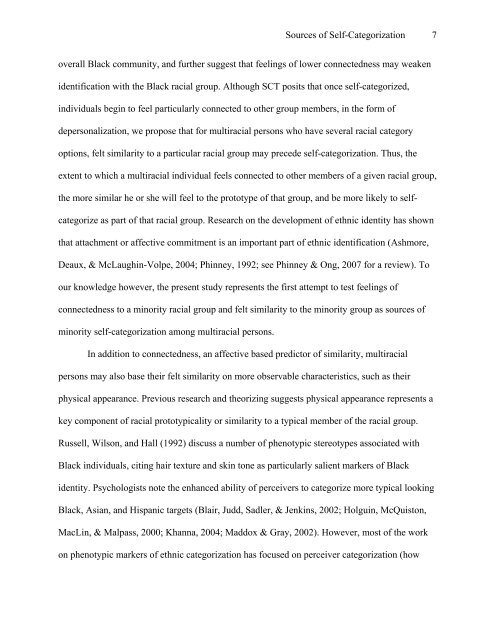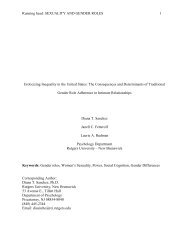Sources of self-categorization as minority for mixed race individuals
Sources of self-categorization as minority for mixed race individuals
Sources of self-categorization as minority for mixed race individuals
You also want an ePaper? Increase the reach of your titles
YUMPU automatically turns print PDFs into web optimized ePapers that Google loves.
<strong>Sources</strong> <strong>of</strong> Self-Categorization 7overall Black community, and further suggest that feelings <strong>of</strong> lower connectedness may weakenidentification with the Black racial group. Although SCT posits that once <strong>self</strong>-categorized,<strong>individuals</strong> begin to feel particularly connected to other group members, in the <strong>for</strong>m <strong>of</strong>depersonalization, we propose that <strong>for</strong> multiracial persons who have several racial categoryoptions, felt similarity to a particular racial group may precede <strong>self</strong>-<strong>categorization</strong>. Thus, theextent to which a multiracial individual feels connected to other members <strong>of</strong> a given racial group,the more similar he or she will feel to the prototype <strong>of</strong> that group, and be more likely to <strong>self</strong>categorize<strong>as</strong> part <strong>of</strong> that racial group. Research on the development <strong>of</strong> ethnic identity h<strong>as</strong> shownthat attachment or affective commitment is an important part <strong>of</strong> ethnic identification (Ashmore,Deaux, & McLaughin-Volpe, 2004; Phinney, 1992; see Phinney & Ong, 2007 <strong>for</strong> a review). Toour knowledge however, the present study represents the first attempt to test feelings <strong>of</strong>connectedness to a <strong>minority</strong> racial group and felt similarity to the <strong>minority</strong> group <strong>as</strong> sources <strong>of</strong><strong>minority</strong> <strong>self</strong>-<strong>categorization</strong> among multiracial persons.In addition to connectedness, an affective b<strong>as</strong>ed predictor <strong>of</strong> similarity, multiracialpersons may also b<strong>as</strong>e their felt similarity on more observable characteristics, such <strong>as</strong> theirphysical appearance. Previous research and theorizing suggests physical appearance represents akey component <strong>of</strong> racial prototypicality or similarity to a typical member <strong>of</strong> the racial group.Russell, Wilson, and Hall (1992) discuss a number <strong>of</strong> phenotypic stereotypes <strong>as</strong>sociated withBlack <strong>individuals</strong>, citing hair texture and skin tone <strong>as</strong> particularly salient markers <strong>of</strong> Blackidentity. Psychologists note the enhanced ability <strong>of</strong> perceivers to categorize more typical lookingBlack, Asian, and Hispanic targets (Blair, Judd, Sadler, & Jenkins, 2002; Holguin, McQuiston,MacLin, & Malp<strong>as</strong>s, 2000; Khanna, 2004; Maddox & Gray, 2002). However, most <strong>of</strong> the workon phenotypic markers <strong>of</strong> ethnic <strong>categorization</strong> h<strong>as</strong> focused on perceiver <strong>categorization</strong> (how



